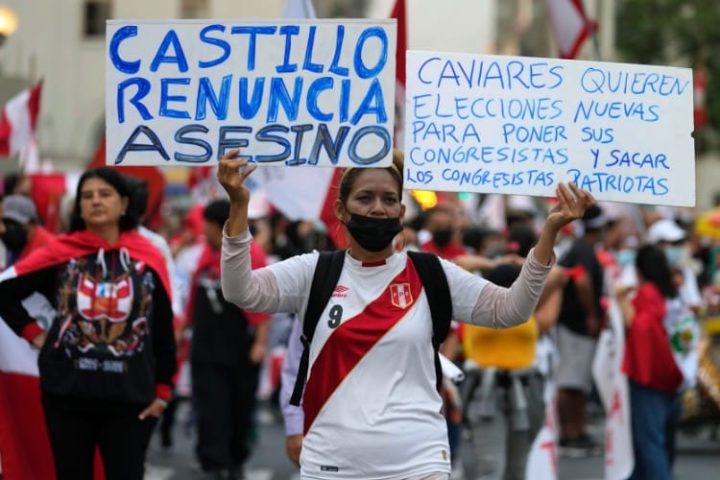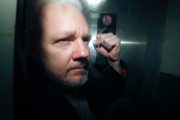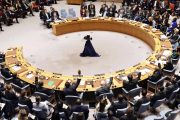
The last few months have seen political unrest in Peru, with street demonstrations and strikes. CNN portrays them as merely one of the consequences of “Putin’s War.” Although the rise in fuel prices has indeed contributed to the current Peruvian crisis, the actual causes and the real meaning of the situation is absent from CNN’s analysis, not surprisingly. Let us delve into the causes and meaning to lift a bit of the veil that covers them.
Peru is a country that has been hit hard by various communist and Marxist-Leninist activities and subversion. One of the deadliest was the Shining Path (Sendero Luminoso), a Maoist communist terrorist organization. This irregular army had large portions of the country under its grip until Alberto Fujimori came to power as Peru’s president in 1990. President Fujimori understood that the main victims of the bloody Maoist guerrillas were the inhabitants of the Andes and the forest. In response, he decided to arm them and train them to face the communist threat (See pages 167-169, 171 and 300 of Comisión por la verdad y la reconciliación and also here).
He also implemented a policy of economic revitalization for those regions that had been laid waste by Shining Path. The plan was a total success. On the one hand, the guerrillas were forced to move to the city, where the police and the army were able to organize intelligence operations against the communist network and finally arrest Abimael Guzmán, the founder and leader of the terrorist group. (See pages 74, 167-169, and 176-178 of Comisión de la verdad y la reconciliación).
On the other hand, a middle class of small agricultural and business people rose and became the backbone of Peru’s economic growth and stability, which lasted for three decades, precisely until the presidency of Pedro Castillo’s — the current president of Peru.
The country is not demonstrating solely because of the rise in combustible fuel prices, as CNN would have one believe. The causes are much deeper. Marxist elites are waging fifth-generation warfare against the Peruvian people.
As in the case of the 2020 U.S. presidential elections, there are those who also suspect that there was widespread fraud in the run-off of the 2021 Peruvian presidential election. The primary suspect of this fraud and responsible for Pedro Castillo’s ascension to power was Martín Vizcarra, a personal friend of Canadian Prime Minister Justin Trudeau and the former president of Peru following the removal of President Pedro Kuczynski. Now Castillo’s parties, Perú Libre (Free Peru) and the Movimiento por la Amnistía y Derechos Fundamentales, also known as MOVADEF (Spanish name and acronym for the Movement for Amnesty and Fundamental Rights) control the national election authorities, the Jurado Nacional de Elecciones and the Oficina Nacional de Procesos Electorales. The difference in votes between presidential candidate Keiko Fujimori (the daughter of former President Alberto Fujimori) and Pedro Castillo was less than one percent — 44,058 votes. Since the election authorities did not make any formal decision about 800 petitions of annulment concerning a high number of electoral minutes, which affected a total of 200,000 votes, the official results are questionable at best. (For more about the doubts concerning the election results, see here and here.)
Second, the Peruvian people fear that the goal of such potential fraud is the imposition of a Marxist tyranny. A brief explanation about the parties that support Pedro Castillo will suffice to corroborate those fears. The founder of Perú Libre is Vladimir Cerrón. He is a medical doctor who spent 11 years of university studies in Communist Cuba and even married to a Cuban woman. There is little doubt he is the link between Pedro Castillo and his communist Cuban advisers. MOVADEF is nothing more than the political arm and transformation of Shining Path (see even Wikipedia, as of April 26, 2022). There is little to no doubt that Peru is at risk of succumbing to communist tyranny. The Peruvian people are far from willing to accept such a turn of events, and the memory of the atrocities committed by the terrorist guerrillas plays an important role in the current unrest.
Third, Peru was the second major producer of copper in the world. However, recently Marxist mobs or mobs paid by Marxists invaded the camp of one of the main copper mines, Las Bambas. A little more than one hundred people from two small towns (Fuerabamba and Huancuire) have stopped the production and the government has refused to intervene in order to protect the property and the workers. Fortunately, on April 27, police decided to intervene, protect property rights, and evict the invaders. Since policemen were prevented from using firearms, a physical confrontation ensued and the mobs managed to set fire to several buildings and machine equipment. The next day, the evicted mob attacked again and committed additional arson. Despite the lack of the use of firearms by the police, the officers were nevertheless accused by the mobs and their supporters of using excessive force. This form of sabotage has had a strong effect over the Peruvian economy. The people feel this and know that this is being caused by small minorities supported by the Marxist rulers. There are reasons for demonstrating very much at odds with CNN’s disinformation.
Fourth, as Víctor Andrés Ponce has summarized the situation,
The social outburst against the Castillo government is due to lack of private investment, lack of employment, because the average income from before the pandemic is not recovered and because poverty increases. And on top of that, the Russian invasion of Ukraine has disrupted oil and the prices of other commodities, which is why the basic basket of Peruvians rises and the people explode against the government of the sombrero (a reference to Pedro Castillo, who often wears a sombrero in public).
Russia’s invasion of Ukraine plays a role, but it is far from being the main reason for the demonstrations that have taken place in Peru. Certain sectors of the Peruvian economy have indeed been affected by the war in Ukraine, such as truckers who have gone on strike. But even in those situations, communists have infiltrated those strikes and demonstrations, causing injuries, destruction to public and private property, and deaths. As Manuel Gago explains in El Montonero:
Communists are experts at creating unrest and conflict. The deaths, during their protests, serve to make their public performance heroic. They are champions at infiltrating demonstrations, popular unions and political parties. They have clearly achieved it in Acción Popular. Because of Castillo — a social agitator, and nothing more — the social and economic collapse of the country is in process. This is how the elementary script of Marxism has been staged: the destruction of the decrepit state in order, on its ashes, to establish a statist and totalitarian one.
Again, this is contrary to the disinformation reported out of CNN.
If the Peruvian government had a normal democratic government, there is little doubt it would fall in the same manner as the governments of former Peruvian Presidents Kuczynski, Vizcarra, and Merino. But Castillo’s government is not a normal democratic government. For that reason, right now the situation has become complicated.
Amidst the protests and Cerrón’s and Castillo’s unpopularity, in classical Marxist style, the government is not turning its back. Rather it is charging forward, applying the old Maoist adage, “the only real defense is active defense.” Hence, on April 5, the 30th anniversary of the dissolution of the Congress by President Alberto Fujimori, President Castillo declared a state of emergency, suspended constitutional rights, and tried to impose a curfew in the hope of avoiding more popular demonstrations. But the people disobeyed the curfew, and it utterly failed.
As a result, the government is now promoting the election of a constitutional assembly, or convention, and has even introduced at the National Congress a proposal for new statutes governing the election of such a constitutional convention. It has also started a strong propaganda campaign to impose a new narrative that Peru’s problems are caused not by the president but by the Congress and that the only way to solve them is to change the constitutional structure of the country through a constitutional convention.
Peruvian elites see right through this strategy but are nevertheless confounded when they see that a small Marxist minority with such strong opposition from the people are able to manipulate the events, seize full power, and impose a totalitarian tyranny over what was up to now a free country. They recognize well, for example, that the proposal of a Constitutional Convention is just a way to disguise a coup d’état and that the coming October local and regional elections will be an appropriate battlefield in which to highlight the weakness of the government; they realize that behind Castillo there are foreign powers conspiring against Peru (they mention Cuban and Russian agents and interests); and they know that Marxists use violence, murder, and anarchy as their main tools. Therefore, they try to devise institutional mechanisms to confront the enemy, such as creating a bicameral Congress in which the Senate could decide an accusation presented by the representatives against the president; or joining the forces of the democratic opposition to present unified candidates to the local and regional elections, and so on. (See here and here.)
But there is an aspect that they do not stress enough. In March 1850, Karl Marx, in his capacity of Central Authority, addressed a discourse to the Communist League. There he said, in order to explain the failures of the League to bring about the revolution in Germany, “A large part of the members who directly participated in the revolutionary movement believed the time for secret societies to have gone by and public activities alone [to be] sufficient.” It is only through the action of secret societies, the infiltration of all organs of the state, including the opposition and even of the church, that Marxism triumphs over its enemies. But this means that only the action of the military and police intelligence could dismantle the structures that undermine any organized resistance against the Marxist totalitarian sect.
The fate of Peru is hanging by a thin thread precisely because the work of communist infiltration seems to be very advanced in that country. The election authorities were infiltrated by appointments made by former President Vizcarra, who was supposed to be a conservative. The judiciary is deeply infiltrated, and for that reason, as the Peruvian opposing elites perceive, the courts seem to suffer a strange “paralysis” and “refuse to apply the laws in order to defend the system of property, and the life and integrity of the citizens,” as one editorial notes. The clergy also comes to the rescue of the godless totalitarian sect every time they are in a precarious position. (See here and here.)
The rule of law is applied by the electoral authorities in a rigid, inequitable way to those who could pose a threat to the government, such as the elected mayor of Lima, Jorge Muñoz, who was removed for attending a Public Firm Board meeting (receiving no income for that attendance) and supposedly holding two conflicting public offices. But at the same time, the same rule is applied in a very lax way to those who are key to the success of the Marxist’s and government’s plans, such as Dina Boluarte, who was a candidate for the second vice-presidency of Peru while being in charge of the Registro Nacional de Identificación y Estado Civil, also known as RENIEC (the Spanish name and acronym for Peru’s National Registry of Identification and Civil Status). Following the 2021 general elections, she simultaneously held the offices of second vice-president of Peru and director of the RENIEC. (See here and here.)
The vast majority of the Peruvian people reject totalitarianism and desire to live in a free republic. But the majority are helpless against the very rigidly and secretly organized minority that is prepared to do whatever necessary to seize power and that is supported by foreign intelligence services with long experience in this type of subversion. Only if some type of a very well-educated and well-organized minority with realistic views and tactics rises to defend the great majority of Peruvians could Peru have any hope of avoiding the nightmare of a communist totalitarian tyranny.



